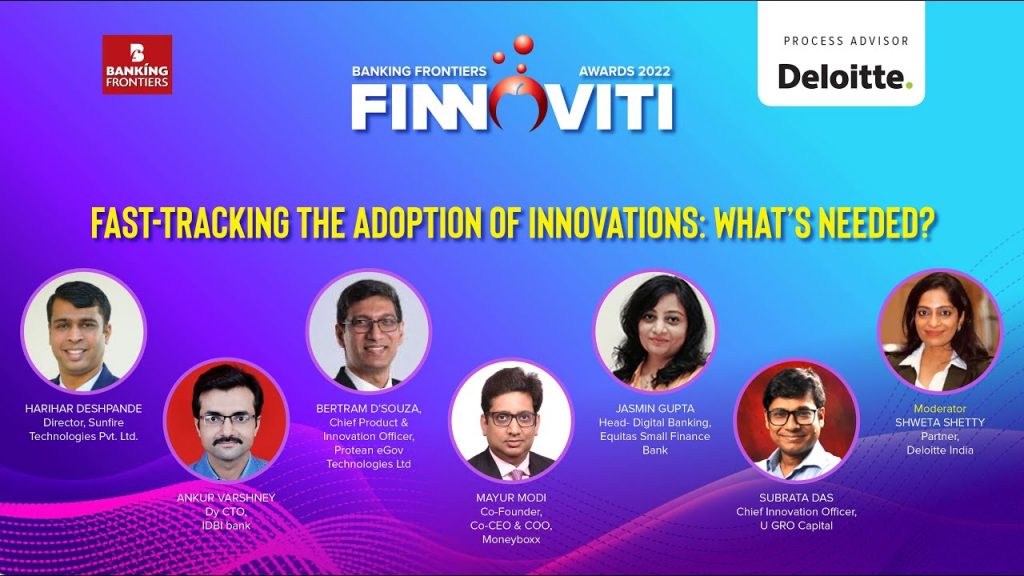Banking Frontiers organized a panel discussion titled ‘Fast Tracking the Adopting on Innovation: What is Needed’ during Finnoviti 2022.

Innovation is driving meta experiments in enterprises. Enterprises are using innovation as a tool to enhance customer experience and reduce the cost of doing business. Shweta Shetty, Partner at Deloitte, spoke about how innovation is driving progress in Greenfield and Brownfield projects. She set the stage by talking about the challenges of integrating legacy systems and modern applications.
INTEGRATING LEGACY WITH NEW
Innovations, says Ankur Varshney, Deputy CTO, IDBI Bank, involve taking risks, and exploring new roads. It is a smart risk.” Although innovative innovations are enabling seamless integration of legacy and modern applications, it is prudent to have a separate ecosystem for new innovations in brownfield projects, especially in large banks and enterprises.
Varshney says about greenfield projects, that many CXOs contemplate a complete transformation strategy. “But it is not feasible. I generally follow the Mikado principal strategy, which calls for one change at a time. Or the rule of three, which involves changing three things at a time or list the top three priorities. This enables tangible and causes less disruption to the business continuity.”
ADDRESSING THE CHALLENGES
Most innovative solutions are not an extension of existing deployments and require a high degree of change management. For example, in the financial services segment, product distribution, underwriting, lending, and fulfilment can become innovation projects of their own, independent of the main product, says Subrata Das, CIO, U GRO Capital.
U GRO Capital has leveraged on the opportunity is targeting the burgeoning SME market, which constitutes 1/3rd of India’s GDP with its offerings. In a bid to solve the credit gap in the SME sector, U GRO has segmented the SMEs, it has divided its TA on a sectoral basis and industries.
The company has integrated APIs with the data sources and is using a data tripod of the customer’s credit history, the bank statement records, and the GST transaction data, combining them by using ML/AI and proprietary lending models to digitally process loans in 60 minutes.
INNOVATION IN FINANCIAL SERVICES
The biggest innovation in the financial service segment has been empowering the customer to go cashless through digital currencies, payment wallets, and digital payments. According to Harihar Deshpande, Director, Sunfire Technologies, customers are driving innovation in the FIs segment. “Now that the innovations are in place, the BFSI segment is thinking of ways to fast-track these innovative solutions and increase outreach.”
Speaking about the next layer of identity and data, Bertram D’Souza, CPIO, Protean e-Gov, said: “Through AADHAAR, we are going into new methods of giving independent access to your own data. Using frameworks like the account aggregator. This does not exist globally and is a first of its kind trend worldwide.”
The industry has witnessed the unbundling of finance, where innovation does not necessarily need to happen within the financial institution. “It happens through collaboration through partnerships, which are enabling the segment to expand to tier 3& 4 towns and cities that did not have access to financial services earlier,” D’Souza said.
EMERGING MODELS
Signifying the importance of the outreach programs to customers in tier 3&4 towns and cities, Mayur Modi, Co-founder Moneyboxx Finance, said his company adopted the education route to engage with customers. He said: “We realized that people struggled with technology and adopted an assisted model to not just fill in the application form, but also walk them through the journey and the process.”
The company is developing partnerships to cross-sell products and services in line with tech maturity. “We are talking about smart gold, in the form of savings. Villagers can save Rs 500 in the form of gold, and then avail credit services, or monetize the asset whenever they want to.”
Dr Jasmine Gupta, CEO & Co-founder, LXME, observes that digital-only banks are a unique emerging business model. “Since the RBI has allowed digital-only banks to start operations, I think it is the journey in the right direction for creating the best possible business model. The move will also help the banks to survive in this industry now that the boundaries between the fintech and banks are blurring.”
MEASURING INNOVATION
Resilient infrastructure that allows enterprises in the BFSI segment to scale-up or scale-down acts as a foundation stone to measure the success of any innovation.
Deshpande of Sunfire Technologies said that robust infrastructure at the bottom contributes to the success of any innovation. “Data sovereignty, regulatory compliances, adoption of technologies like hybrid cloud computing to drive cost and operational efficiency pivots the innovation.”
Shetty of Deloitte added: “The success of innovation is measured in terms of customer stickiness, customer experience, and top-line growth. But it is also dependent on the underlying infrastructure.”
THE CLOUD ROADMAP
The journey to the cloud is foggy for most large BFSI organizations. Varshney of IDBI Bank asserted infrastructure-as-a-service (IAAS) is one of the overlooked aspects of any innovation in larger organizations compared to the SMEs or start-ups that have natively grown on the cloud.
Secondly, most fintech companies are built on an open stack, which has interoperability issues with the existing infrastructure of the banks, which are governed by several regulatory and compliance mandates.
The need of the hour, said Varshney, is to develop a dynamic, elastic, hyper-scale cloud in partnership with public cloud providers. A consortium of banks has submitted a paper to RBI seeking permission to migrate some non-critical workloads onto the public cloud. The proposal is supported by the fact that most banks have migrated some critical and largely non-critical applications on the private or on-premise cloud.
INNOVATION & ROI
The businesses in the BFSI segment are drafting interesting strategies or tweaking their business models to map ROI with investments in innovation. D’Souza of Protean e-Gov has formed two teams in which one team is responsible for new products and innovation, and the other team measures the output from an ROI and a market opportunity perspective.
“The thought process was that for any new product, there should always be the customer element. For example, after creaing a new product from scratch, if the market does not accept it, you turn it around for a while or scrap it and start anew.”
The second lever to map ROI with innovation is the use of advanced technology and tech tools which will allow the fintech companies to utilize the AA and the new ONDC frameworks to allow companies battling for customer engagement to build commerce journeys in their own apps. Commerce does not need to happen on Amazon or Flipkart anymore. It can now get decentralized or unbundled. And again, that opens opportunities both for banks to bring customers back into their digital apps, or for fintechs to do other services today on a consumer-facing app, and create an engagement layer, which is not just throwing cash back, it can be differentiated on experience.”
Deshpande of Sunfire Technologies opined that it is important to look at the aspects such as the cost of opportunity lost for not innovating and its impact.
“For that, businesses must create a sandbox kind of environment, or run pilots and obtain feedback for continuous transformation. As you create a new framework, the learnings increase. Going forward, the small sandbox environment will evolve, and become bigger and a successful innovation going forward.”
THE BINDING THREADS
Toward the end of the panel discussion, Shetty of Deloitte asked a vital question: “Despite collaborations between traditional players, non-traditional players and challenger banks, innovation is also about falling, failures, and challenges. What is the thread that binds innovation with business outcomes?”
Das of U GRO Capital informed that innovation is a part of the design which sits at the heart of a business model, and there is a need to involve all the stakeholders at each stage and drive the process cross-functionally.
According to him, failure could result from two situations – one original thinking and the premise being wrong, and two, the design was right. Still, the execution did not yield the desired result. “I think the second situation is what we encountered the most.”
Taking a leaf out of Jacob Goldenberg’s book Inside the Box, Dr Jasmine Gupta of LXME said one does not have to look afar for innovations; you find solutions to problem statements within the ecosystem. “That is what we observe in the financial ecosystem as well. There are enough use cases that showcase the benefits of collaboration. In the BFSI segment, banks bring to the table strong systems and processes, and compliance regulation. Fintech comes with agility, speed to market and nimble footedness. Collaboration is a win-win for all the players in the industry. And I think the need of the hour is innovative ecosystem-based solutions based on sectoral analysis and specific to the target segment.”
Sharing an example of collaboration, she said, banks and fintech companies are collaborating with start-ups to gain access to the bank’s API sandbox, and for technical, marketing and compliance support, which helps banks and start-ups to co-create, collaborate and take the product to the market.
CONCLUSION
Innovation plays a vital role in turn-around the BFSI segment, which is normally associated with the traditional route for growth. In the recent past, the segment has embraced not just advanced tech tools but also is collaborating with like-minded partners to upsell and cross-sell products and services. The innovation journey has just begun, and the segment is gleefully lapping it up!
________________________
Read more-







